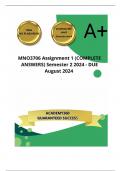MNO3706 Assignment 1 (COMPLETE ANSWERS) Semester 2 2024 - DUE August 2024 ; 100% TRUSTED Complete, trusted solutions and explanations. 1. Explain the use the technique used to measure or manage risk. (10) Measuring and managing risk is crucial for identifying potential hazards and minimizing their impact on an organization. Various techniques and methods are used to assess and control risk. Here’s an overview of some key techniques used for risk measurement and management: 1. Risk Assessment: Explanation: • Definition: Risk assessment involves identifying potential hazards, evaluating their likelihood and impact, and determining the appropriate controls to mitigate the risks. • Process: Typically includes hazard identification, risk analysis, and risk evaluation. • Application: Used to prioritize risks based on their severity and probability, and to develop strategies for managing them. 2. Risk Matrix: Explanation: • Definition: A risk matrix is a visual tool that helps categorize and prioritize risks based on their likelihood of occurrence and potential impact. • Process: Risks are plotted on a matrix with axes representing probability and impact, resulting in categories such as low, medium, or high risk. • Application: Helps in determining which risks require immediate attention and resources. 3. Failure Modes and Effects Analysis (FMEA): Explanation: • Definition: FMEA is a systematic method for evaluating potential failure modes within a system a nd assessing their impact on operations. • Process: Identifies failure modes, their causes, and consequences, and assigns a risk priority number (RPN) based on severity, occurrence, and detection. • Application: Used in manufacturing and engineering to improve product reliability and safety. 4. Fault Tree Analysis (FTA): Explanation: • Definition: FTA is a deductive method used to analyze the causes of system failures. • Process: Constructs a fault tree diagram that starts with a top-level failure event and breaks it down into contributing causes using logical gates. • Application: Helps in understanding complex systems and identifying root causes of failures. 5. Hazard and Operability Study (HAZOP):




